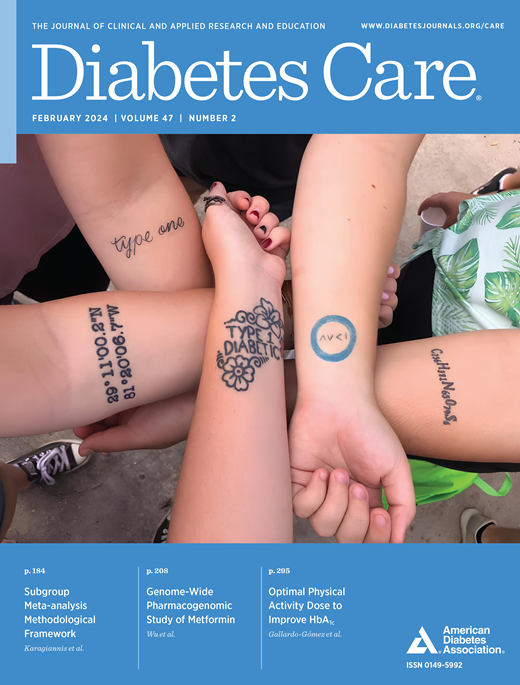糖尿病诊断年龄与终生痴呆风险:社区动脉粥样硬化风险(ARIC)研究
IF 14.8
1区 医学
Q1 ENDOCRINOLOGY & METABOLISM
引用次数: 0
摘要
目的 糖尿病确诊年龄对整个生命过程中痴呆症风险的影响尚不明确。我们估算了糖尿病确诊年龄对终生痴呆症风险的影响。研究设计与方法 我们纳入了 13,087 名社区动脉粥样硬化风险研究(Atherosclerosis Risk in Communities Study)的参与者,他们在 60 岁时没有患痴呆症。我们将参与者分为中年糖尿病患者(诊断年龄为 60 岁)、老年糖尿病患者(诊断年龄为 60-69 岁)或无糖尿病患者。发病痴呆症通过判定和主动监测确定。我们使用累积发病率函数估算器,根据糖尿病诊断年龄确定终生痴呆风险,同时考虑死亡率的竞争风险。我们使用限制性平均生存时间来计算无痴呆症和有痴呆症的生存年数。结果 在 13,087 名参与者中,有 2,982 人患有痴呆症,4,662 人在中位随访 24.1 年(百分位数 25- 百分位数 75,17.4-28.3)期间无痴呆症死亡。中年糖尿病患者终生罹患痴呆症的风险明显高于老年糖尿病患者(36.0% 对 31.0%)。与未患糖尿病的人相比,中年糖尿病患者到80岁时痴呆症的累积发病率也更高(16.1% 对 9.4%),但由于存活时间较短,终生痴呆症的风险较低(36.0% 对 45.6%)。中年糖尿病患者比非糖尿病患者和老年糖尿病患者分别早4年和1年患痴呆症。结论 预防或延缓糖尿病可能是降低终生痴呆症风险的重要方法。本文章由计算机程序翻译,如有差异,请以英文原文为准。
Age of Diabetes Diagnosis and Lifetime Risk of Dementia: The Atherosclerosis Risk in Communities (ARIC) Study
OBJECTIVE The impact of age of diabetes diagnosis on dementia risk across the life course is poorly characterized. We estimated the lifetime risk of dementia by age of diabetes diagnosis. RESEARCH DESIGN AND METHODS We included 13,087 participants from the Atherosclerosis Risk in Communities Study who were free from dementia at age 60 years. We categorized participants as having middle age–onset diabetes (diagnosis <60 years), older-onset diabetes (diagnosis 60–69 years), or no diabetes. Incident dementia was ascertained via adjudication and active surveillance. We used the cumulative incidence function estimator to characterize the lifetime risk of dementia by age of diabetes diagnosis while accounting for the competing risk of mortality. We used restricted mean survival time to calculate years lived without and with dementia. RESULTS Among 13,087 participants, there were 2,982 individuals with dementia and 4,662 deaths without dementia during a median follow-up of 24.1 (percentile 25–percentile 75, 17.4–28.3) years. Individuals with middle age–onset diabetes had a significantly higher lifetime risk of dementia than those with older-onset diabetes (36.0% vs. 31.0%). Compared with those with no diabetes, participants with middle age–onset diabetes also had a higher cumulative incidence of dementia by age 80 years (16.1% vs. 9.4%), but a lower lifetime risk (36.0% vs. 45.6%) due to shorter survival. Individuals with middle age–onset diabetes developed dementia 4 and 1 years earlier than those without diabetes and those with older-onset diabetes, respectively. CONCLUSIONS Preventing or delaying diabetes may be an important approach for reducing dementia risk throughout the life course.
求助全文
通过发布文献求助,成功后即可免费获取论文全文。
去求助
来源期刊

Diabetes Care
医学-内分泌学与代谢
CiteScore
27.80
自引率
4.90%
发文量
449
审稿时长
1 months
期刊介绍:
The journal's overarching mission can be captured by the simple word "Care," reflecting its commitment to enhancing patient well-being. Diabetes Care aims to support better patient care by addressing the comprehensive needs of healthcare professionals dedicated to managing diabetes.
Diabetes Care serves as a valuable resource for healthcare practitioners, aiming to advance knowledge, foster research, and improve diabetes management. The journal publishes original research across various categories, including Clinical Care, Education, Nutrition, Psychosocial Research, Epidemiology, Health Services Research, Emerging Treatments and Technologies, Pathophysiology, Complications, and Cardiovascular and Metabolic Risk. Additionally, Diabetes Care features ADA statements, consensus reports, review articles, letters to the editor, and health/medical news, appealing to a diverse audience of physicians, researchers, psychologists, educators, and other healthcare professionals.
 求助内容:
求助内容: 应助结果提醒方式:
应助结果提醒方式:


